Back to Product Page
|
INSTALLATION,
OPERATION, &
MAINTENANCE MANUAL
|
|
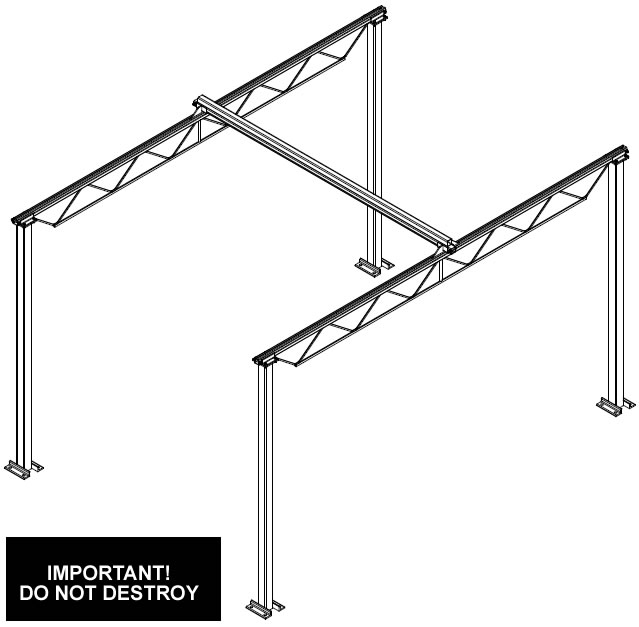 |
|
| PARTS
LIST |
| See
packing list for specific quantities. |
|
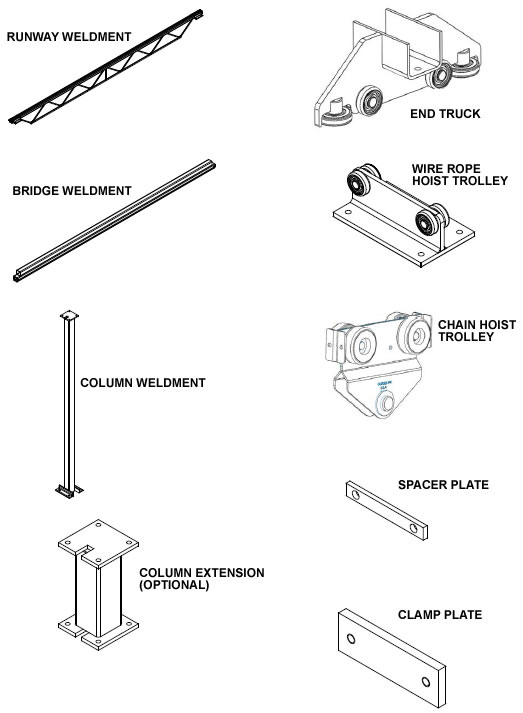 |
|
| PARTS
LIST |
| See
packing list for specific quantities. |
|
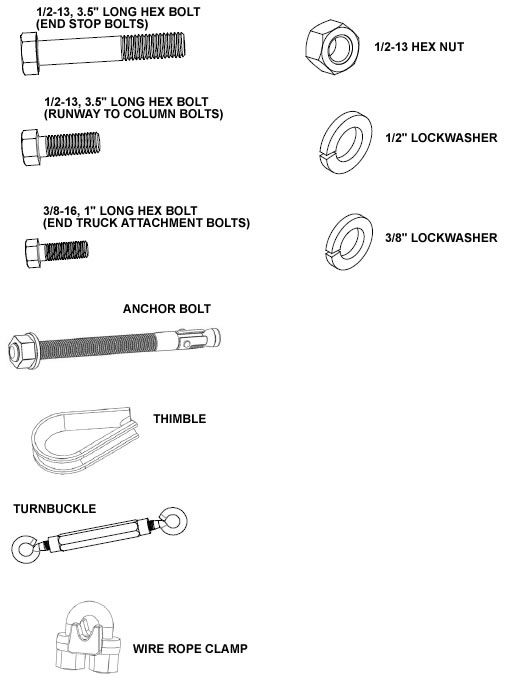 |
|
| INTRODUCTION |
|
Thank
you for choosing a Shop Crane. The innovative design and solid
construction of Shop Cranes will provide
a superior quality product. Shop Crane is pre-engineered for
powered hoist operation. The hoist weight allowance
is 15% of the crane capacity (for example, a crane rated for
1000 pounds, allows for a 1000-pound live load plus
150 pounds for the weight of the hoist). There is also an allowance
of 25% of the crane capacity for impact caused
by hoist use. The Shop Crane will provide many years of dependable
service by following the installation and
maintenance procedures described herein. |
|
Dimensions
contained in this installation manual are for reference only
and may differ for your particular
application. Please refer to the enclosed General Arrangement
Drawing for actual dimensions. |
|
Normal
safety precautions: These include, but are not limited to:
o Checking for obstructions in crane travel
o Checking that all bolts are tight and have lockwashers
o Making sure that endstops are in place
o Making sure that festooning cannot be snagged or pinched,
whether it is electric or pneumatic
o For additional safety precautions, see below (Crane Operator
Instructions). |
|
|
WARNING
|
A
minimum of a 6" - thick reinforced concrete floor is required.
Shop crane assumes no responsibility for adequacy
or integrity of the mounting surface. Support assemblies are
designed to AISC (American Institute of Steel
Construction) specifications. See bottom of page for maintenance
schedule. |
|
|
WARNING
|
Equipment
described herein is not designed for, and should not be used
for, lifting, supporting or transporting humans.
Failure to comply with any one of the limitations noted herein
can result in serious bodily injury and/or property damage. |
|
|
WARNING
|
Crane
cannot be utilized as a ground: A separate ground wire is required.
For example, systems with 3-phase power
require three conductors plus one ground wire. |
|
|
WARNING
|
Reference
the American Institute of Steel Construction (AICS) Manual of
Steel Construction (9th edition), Part 5,
Specification for Structural Joints using ASTM A325 or A490
Bolts (section 8.d.2) for the proper procedures to
follow when using any torque tightening method. |
|
| INSTALLATION |
| STEP
1 - PRE-ASSEMBLY |
|
|
|
|
|
|
 |
|
|
|
|
|
|
| 1.1
Check packing list to make sure correct quantity of parts
is included. |
|
|
|
|
|
|
| 1.2
Tools and materials typically needed to assemble crane are as
follows: |
|
|
|
|
|
|
|
|
|
o
Mallet
o Chalk line
o Hand tools
o Shop brush
o Steel shims
o Large square
o Heavy duty drill/Hammer drill |
o
Concrete drill bits
o Shop vacuum
o Torque wrench (able to torque up to 95 ft.-lbs.)
o Tape measure
o Ladders/man lifts
o Leveling tools (transit, laser level, water level, etc.) |
|
|
|
|
|
|
|
|
|
|
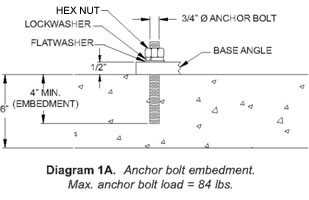 |
| 1.3
Anchor bolts and concrete floor guidelines: |
|
|
|
|
|
|
o
Use 3/4", grade 5 anchor bolts (included).
o Anchor bolts must be embedded at least
4" into floor, not to exceed 3/4 of floor
depth
(diagram 1A). |
|
|
|
|
|
|
|
Note:
A minimum 6".thick reinforced
concrete floor is required. If other style
anchor or floor conditions exist consult
anchor manufacturer for requirements. |
|
|
|
|
|
|
| STEP
2 - COLUMN WELDMENT INSTALLATION |
|
|
|
|
 |
|
|
|
|
| 2.1
Lay out and mark on floor exact position of column weldments
prior to proceeding with installation (refer to enclosed General
Arrangement Drawing for recommended dimensions and column weldment
location). |
|
 |
|
|
|
|
2.2
Position first column weldment in place. Orient
column cap plate (top of column) as shown in
diagram 2A. |
|
|
|
|
|
2.3
While supporting column weldment, drill holes
in concrete floor using pre-drilled holes in column
weldment base angles as a guide (use 3/4" drill bit).
Vacuum or brush away cement dust |
|
|
|
|
|
2.4
Install anchor bolts and hardware according to
diagram 1A. Do not fully torque nuts at this point. |
|
|
|
|
|
|
|
|
|
| 2.5
Check to see if column weldment is plumb. If column weldment
is not plumb, place steel shims (not included) or grout (not
included) under base of column weldment until plumb. After column
weldment is plumb, tighten all nuts to recommended torque of
70 ft/lb. |
|
|
|
|
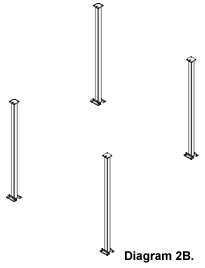 |
|
|
|
|
2.6
Install remaining column weldments (repeat
Steps 2.2 through 2.5). Add grout under base. |
|
|
|
|
|
|
| STEP
3 . RUNWAY INSTALLATION |
|
3.1
Set the runways on top of the columns. Attach runways to columns
using four (4) 1/2-13, 1.5" long bolts,
hex nuts and lockwashers per column. |
|
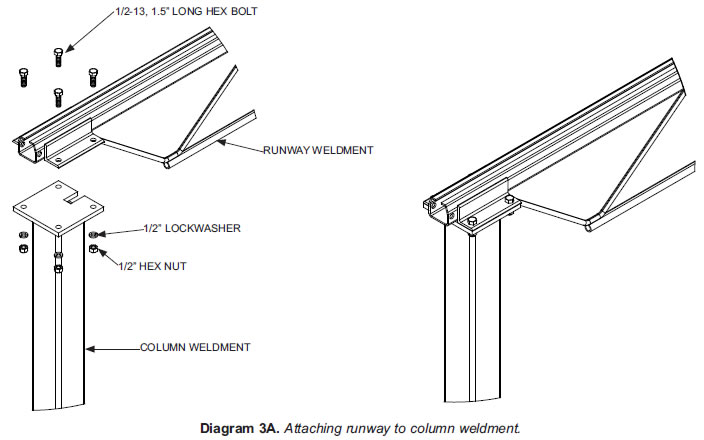 |
|
|
|
| 3.2
Level runways and make sure that they are parallel within +/-
1/16". Use shims under whole bracket if necessary.
|
|
|
|
|
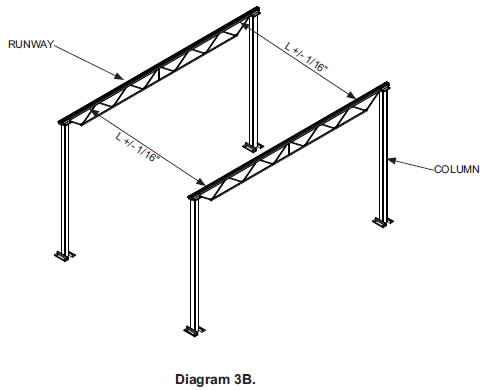 |
|
|
| STEP
4 . BRIDGE AND END TRUCK INSTALLATION |
|
|
|
|
|
| 4.1
Slide both end trucks into the runways (diagram 4A).
|
|
|
|
|
|
|
TIP:
Clean interior of tracks prior to end truck installation
using dry vac or compressed air. |
|
|
|
|
|
|
|
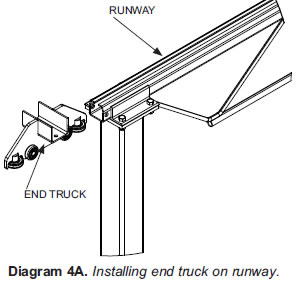 |
|
|
|
|
|
|
|
| 4.2
Install end stops into the runways (diagram 4B). |
|
|
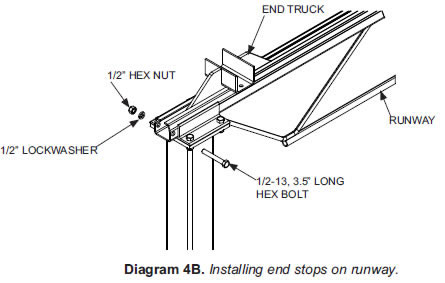 |
|
|
|
|
|
| 4.3
Slide hoist trolley into the bridge first. |
|
|
|
|
|
TIP:
Clean interior of bridge track prior to trolley installation. |
|
|
|
|
|
|
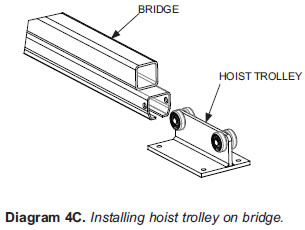 |
|
|
|
|
|
| 4.4
Install end stops into both ends of the bridge using 1/2-13,
3.5" long hex bolts, 1/2" hex nut and the 1/2"
lockwasher. |
|
|
|
|
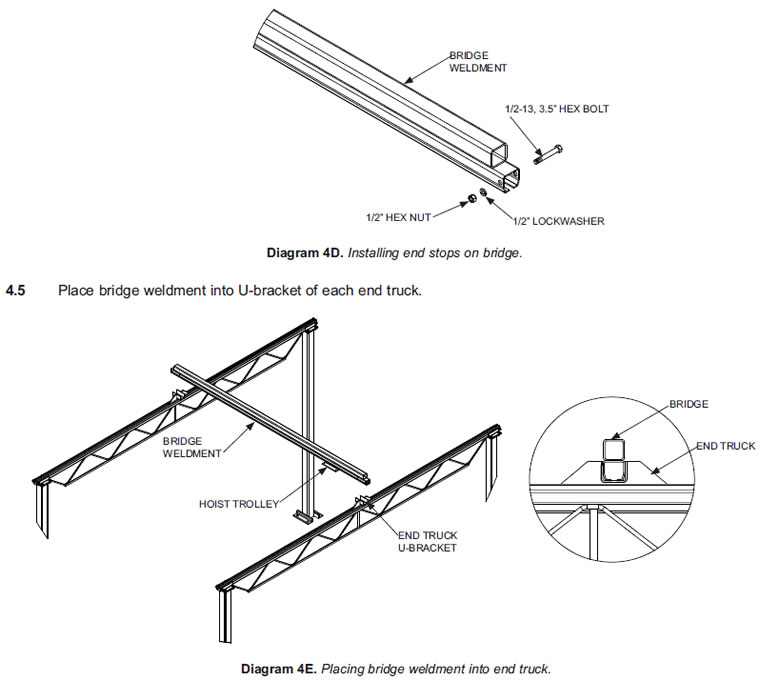 |
|
|
|
4.6
Attach bridge weldment to the end trucks using
clamp plate and spacer plate at one end. Make sure
that the end truck at this end slides freely along the
bridge. Center the bridge between end trucks
and clamp opposite end truck to the bridge
using the clamp plate without a spacer plate.
Tighten two (2) 3/8-16, 1" long hex bolts until
lockwasher is flattened. |
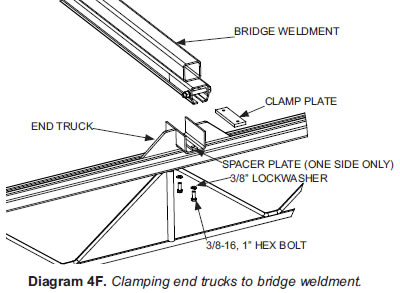 |
|
|
|
|
 |
|
|
|
4.7
Roll bridge down the length of the runways to
check for smooth travel. If travel is not smooth,
check each runway track to ensure that it is properly
leveled, and that the runways are parallel. Also, check
to make sure that only one end truck is clamped to the
bridge. Level bridge. Adjust at column connections
if needed. |
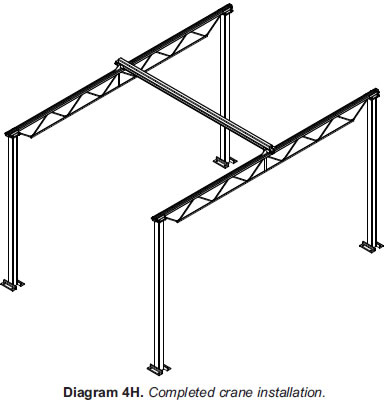 |
|
|
|
| STEP
5 - HOIST ATTACHMENT |
|
|
|
|
|
5.1
Wire rope hoist attachment (diagram 5A) Attach wire rope hoist
to hoist trolley using four 10mm hex bolts and 10mm lock washers
included with wire rope hoist. Terminate power as required.
|
|
|
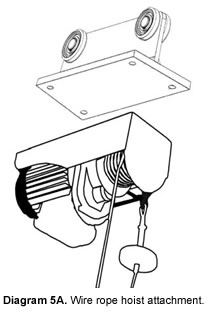 |
|
|
|
|
5.2
Standard hoist trolley attachment (diagram 5B) Attach hoist
to
hoist trolley by snapping hoist suspension hook over the trolley
saddle
clevis pin of hoist trolley |
|
|
|
|
|
|
|
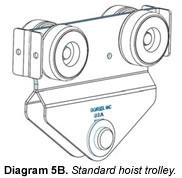 |
|
|
| STEP
6 - RUNWAY TAGLINE INSTALLATION |
|
|
|
6.1
Loop cable through turnbuckle and turn back of cable on a thimble.
Apply clamp as close to thimble as possible.
Tighten u-bolt to 10 ft.-lbs. of torque. |
|
|
|
|
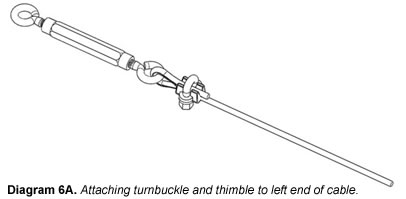 |
|
|
|
|
|
| STEP
7 - COLUMN EXTENSION INSTALLATION |
|
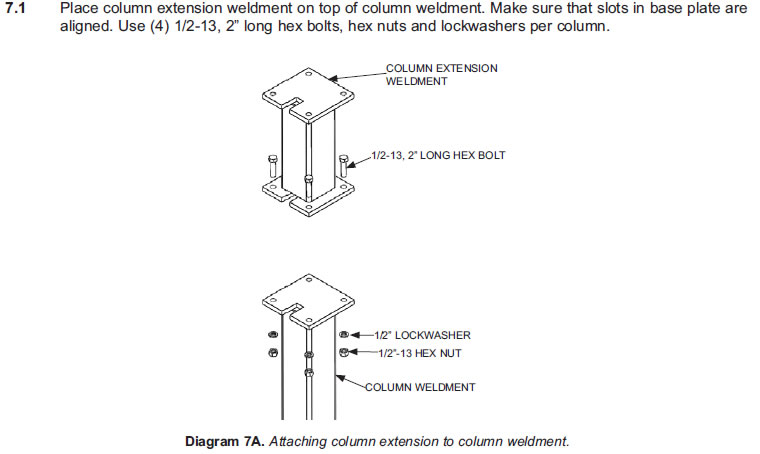 |
|
 |
|
| CRANE
OPERATOR INSTRUCTIONS |
Overhead
cranes generally handle materials over working areas where there
are personnel. Therefore, it is important
for the Crane Operator to be instructed in the use of the crane
and to understand the severe consequences of careless
operation. It is not intended that these suggestions take precedence
over local codes. However, a thorough study of
the following information should provide a better understanding
of safe operation and afford a greater margin of
safety. It must be recognized that these are suggestions for
the Crane Operator's use. It is the responsibility of the
owner to make operators aware of all federal, state and local
rules and codes, and to make certain operators are
properly trained. |
|
|
Qualifications
Crane operation, to be safe and efficient, requires skill: the
exercise of extreme care and good judgment, alertness and
concentration, and rigid adherence to proven safety rules and
practices. In general practice, no person should be
permitted to operate a crane: |
|
o
Who cannot speak the appropriate language or read and understand
the printed instructions.
o Who is not of legal age to operate this type of equipment.
o Whose hearing or eyesight is impaired (unless suitably corrected
with good depth perception).
o Who may be suffering from heart or other ailments which might
interfere with the operator's safe performance.
o Who is under the influence or impaired by alcohol, legal,
or illegal drugs.
o Unless the operator has carefully read and studied this operation
manual.
o Unless the operator has been properly instructed.
o Unless the operator has demonstrated his instructions through
practical operation.
o Unless the operator is familiar with hitching equipment and
safe hitching equipment practices. |
|
|
Handling
the Bridge Travel Motion
Before using the bridge of the crane, the operator should be
sure the hook is high enough to clear any obstructions.
Before a load is handled by the crane, the bridge should be
brought into position so that it is directly over the load.
Start the bridge slowly and bring it up to speed gradually.
Approaching the place where it is desired to stop the
bridge, reduce the bridge speed. |
|
|
Handling
the Trolley Motion
Before a load is handled, the hoist shall be positioned directly
over the load that is to be handled. When the slack is
taken out of the slings, if the hoist is not directly over the
load, bring it directly over the load before hoisting is
continued. Failure to center the hoist over the load may cause
the load to swing upon lifting. Always start the trolley
motion slowly and reduce the trolley speed gradually. |
|
|
Handling
the Hoist Motion
Refer to the lifting (hoist) equipment's operating instructions.
|
|
| GENERAL
SUGGESTIONS |
|
Know
Your Crane
Crane operators should be familiar with the principal parts
of a crane and have a thorough knowledge of crane
control functions and movements. The crane operator should be
required to know the location and proper
operation of the main conductor disconnecting means for all
power to the attachments on the crane. |
|
Responsibility
Each crane operator should be held directly responsible for
the safe operation of the crane. Whenever there is any
doubt as to SAFETY, the crane operator should stop the crane
and refuse to handle loads until: (1) safety has been
assured or (2) the operator has been ordered to proceed by the
supervisor, who then assumes all responsibility for
the SAFETY of the lift. Do not permit ANYONE to ride on the
hook or a load. |
|
Inspection
Test the crane movement and any attachments on the crane at
the beginning of each use. Whenever the operator
finds anything wrong or apparently wrong, the appropriate corrective
action should be taken. |
|
Operating
Suggestions
One measure of a good crane operator is the smoothness of the
crane operation. The good crane operator should
know and follow these proven suggestions for safe, efficient
crane handling. |
|
1.
The crane should be moved smoothly and gradually to avoid abrupt,
jerky movements of the load. Slack must
be removed from the sling and hoisting
ropes before the load is lifted.
2. Center the crane over the load before starting the hoist
to avoid swinging the load as the lift is started. Loads
should not be swung by the crane to
reach areas not under the crane.
3. Crane-hoisting ropes should be kept vertical. Cranes shall
not be used for side pulls.
4. Be sure everyone in the immediate area is clear of the load
and aware that a load is being moved.
5. Do not make lifts beyond the rated load capacity of the crane,
sling chains, rope slings, etc.
6. Make certain that before moving the load, load slings, load
chains, or other lifting devices are fully seated in the
saddle of the hook with hook latch closed
(if equipped with hook latch).
7. Check to be sure that the load and/or bottom block is lifted
high enough to clear all obstructions when moving
boom or trolley.
8. At no time should a load be left suspended from the crane
unless the operator has the push button with the power
on, and under this condition keep the load
as close as possible to the floor to minimize the possibility
of an injury if
the load should drop. When the crane is holding
a load, the crane operator should remain at the push button.
9. Do not lift loads with sling hooks hanging loose. If all
sling hooks are not needed, they should be properly stored,
or use a different sling.
10. All slings or cables should be removed from the crane hooks
when not in use (dangling cables or hooks hung in
sling rings can inadvertently snag
other objects when the crane is moving).
11. Operators shall not carry loads and/or empty bottom blocks
over personnel. Particular additional caution should
be practiced when using
magnet or vacuum devices. Loads, or parts of loads, held magnetically
could drop.
Failure of power to magnets
or vacuum devices can result in dropping the load. Extra precaution
should be
exercised when handling molten
metal in the proximity of personnel. |
|
|
|
| 12.
Whenever the operator leaves the crane the following procedure
should be followed: |
|
o
Raise all hooks to an intermediate position.
o Spot the crane at an approved designated location.
o Place all controls in the "off" position.
o Open the main switch to the "off" position.
o Make visual check before leaving the crane. |
|
13. In case of emergency or during inspection, repairing, cleaning
or lubrication, a warning sign or signal should be
displayed and the main switch should
be locked in the "off" position. This should be done
whether the work is
being done by the crane operator or
by others.
14. Contact with trolley end stops shall be made with extreme
caution. The operator should do so with particular
care for the safety of the persons
below the crane, and only after making certain that any persons
on the other
cranes are aware of what is being
done.
15. ANY SAFETY FEATURES AND MECHANISMS BUILT-IN OR OTHERWISE
PROVIDED WITH THE
CRANE BY THE COMPANY ARE REQUIRED
FOR THE SAFE OPERATION OF THE CRANE.
DO NOT, UNDER ANY CIRCUMSTANCES, REMOVE
OR OTHERWISE IMPAIR OR DISABLE THE
PROPER FUNCTIONING OF ANY CRANE SAFETY
MECHANISMS OR FEATURES BUILT-IN OR
OTHERWISE PROVIDED BY THE COMPANY
FOR SAFE OPERATION OF THE CRANE. ANY
REMOVAL, IMPAIRMENT OR DISABLING OF
ANY SUCH SAFETY MECHANISMS OR FEATURES
OR OTHER USE OR OPERATION OF THE CRANE
WITHOUT THE COMPLETE AND PROPER
FUNCTIONING OF ANY SUCH SAFETY
MECHANISMS OR FEATURES AUTOMATICALLY AND
IMMEDIATELY VOIDS ANY AND ALL EXPRESS
AND IMPLIED WARRANTIES OF ANY KIND
OR NATURE. |
|
|
| LIMITED
WARRANTY |
|
|
It
is agreed that the equipment purchased hereunder is subject
to the following LIMITED warranty and no other. The
Company, warrants the manual push-pull Shop Crane by Gorbel
products to be free from defects in material or
workmanship for a period of two years or 1,000 hours use from
date of shipment.This warranty shall not cover failure
or defective operation caused by operation in excess of recommended
capacities, misuses, negligence or accident,
and alteration or repair not authorized by The Company. No system
shall be modified after manufacture without the
written authorization of The Company. Any field modification
made to the system without the written authorization of
The Company shall void The Company's warranty obligation. OTHER
THAN AS SET FORTH HEREIN, NO
OTHER EXPRESS WARRANTIES, AND NO IMPLIED WARRANTIES, ORAL OR
WRITTEN, INCLUDING
BUT NOT LIMITED TO THE WARRANTIES OF MERCHANTABILITY OR FITNESS
FOR A PARTICULAR
PURPOSE, ARE MADE BY THE COMPANY WITH RESPECT TO ITS PRODUCTS
AND ALL SUCH
WARRANTIES ARE HEREBY SPECIFICALLY DISCLAIMED. THE COMPANY SHALL
NOT BE LIABLE
UNDER ANY CIRCUMSTANCES FOR ANY INCIDENTAL, SPECIAL AND/OR CONSEQUENTIAL
DAMAGES WHATSOEVER, WHETHER OR NOT FORESEEABLE, INCLUDING BUT
NOT LIMITED TO
DAMAGES FOR LOST PROFITS AND ALL SUCH INCIDENTAL, SPECIAL AND/OR
CONSEQUENTIAL
DAMAGES ARE HEREBY ALSO SPECIFICALLY DISCLAIMED. The Company's
obligation and Purchaser's
or end user's sole remedy under this warranty is limited to
the replacement or repair of The Company's products at
the factory, or at the discretion of The Company, at a location
designated by The Company. Purchaser or end user
shall be solely responsible for all freight and transportation
costs incurred in connection with any warranty work
provided by The Company hereunder. The Company will not be liable
for any loss, injury or damage to persons
or property, nor for damages of any kind resulting from failure
or defective operation of any materials or equipment
furnished hereunder. Components and accessories not manufactured
by The Company are not included in this
warranty. Purchaser's or end user's remedy for components and
accessories not manufactured by The Company is
limited to and determined by the terms and conditions of the
warranty provided by the respective manufacturers of
such components and accessories. |
|
A)
DISCLAIMER OF IMPLIED WARRANTY OF MERCHANTABILITY
The Company and Purchaser agree that the implied warranty of
merchantability is excluded from this
transaction and shall not apply to the goods involved in this
transaction.
B) DISCLAIMER OF IMPLIED WARRANTY OF FITNESS FOR PARTICULAR
PURPOSE
The Company and Purchaser agree that the implied warranty of
fitness for particular purpose is excluded
from this transaction and shall not apply to the goods involved
in this transaction.
C) DISCLAIMER OF EXPRESS WARRANTY
The Company's agents, or dealer's agents, or distributor's agents
may have made oral statements about the
machinery and equipment described in this transaction. Such
statements do not constitute warranties, and
Purchaser agrees not to rely on such statements. Purchaser also
agrees that such statements are not part of
this transaction.
D) DISCLAIMER OF SPECIAL, INCIDENTAL AND CONSEQUENTIAL DAMAGES
The Company and Purchaser agree that any claim made by Purchaser
which is inconsistent with The
Company's obligations and the warranty remedies provided with
The Company's products, and in particular,
special, incidental and consequential damages, are expressly
excluded.
E) DEALER OR DISTRIBUTOR NOT AN AGENT
The Company and Purchaser agree that Purchaser has been put
on notice that dealer or distributor is not
The Company's agent in any respect for any reason. The Company
and Purchaser also agree that Purchaser
has been put on notice that dealer or distributor is not authorized
to incur any obligations or to make any
representations or warranties on The Company's behalf other
than those specifically set forth in The
Company's warranty provided in connection with its product.
F) MERGER
This warranty agreement constitutes a final and complete written
expression of all the terms and conditions
of this warranty and is a complete and exclusive statement of
those terms.
G) PAINTING
Every crane (excluding components) receives a quality paint
job before leaving the factory. |
|
Title
and Ownership:
Title to the machinery and equipment described in the foregoing
proposal shall remain with The Company and shall
not pass to the Purchaser until the full amount herein agreed
to be paid has been fully paid in cash. |
|
Claims
and Damages:
Unless expressly stated in writing, goods and equipment shall
be at Purchaser's risk on and after Seller's delivery in
good shipping order to the Carrier. Any modifications or alterations
to equipment and equipment not provided by
The Company are the responsibility of the owner. |
|
Cancellations:
If it becomes necessary for the purchaser to cancel this order
wholly or in part, he shall at once so advise The
Company in writing. Upon receipt of such written notice all
work will stop immediately. If the order entails only
stock items, a flat restocking charge of 15% of the purchase
price will become due and payable by Purchaser to
The Company. |
|
Returns:
No equipment, materials or parts may be returned to The Company
without express permission in writing to do so.
Returns are subject to a restocking fee. Once installed, products
may not be returned. Products must be in their
original packaging (skidded and banded). Customer is responsible
for return freight. |
|
Changes
and Alterations:
The Company reserves the right to make changes in the details
of construction of the equipment, as in its judgment,
will be in the interest of the Purchaser; will make any changes
in or additions to the equipment which may be agreed
upon in writing by the Purchaser; and The Company is not obligated
to make such changes in products previously
sold any customer. |
|
Third
Party Action:
Should The Company have to resort to third party action to collect
any amount due after thirty (30) days from date
of invoice, the Purchaser agrees to pay collection costs, reasonable
attorney?s fees, court costs and legal interest. |
|
Owner
Responsibilities:
Owner takes responsibilities for all applicable building, safety
and other regulatory codes in their area. |
|
Equal
Employment Opportunity:
The Company agrees to take affirmative action to ensure equal
employment opportunity for all job applicants
and employees without regard to race, color, age, religion,
sex, national origin, handicap, veteran, or marital status.
The Company agrees to maintain non-segregated work facilities
and comply to rules and regulations of the Secretary
of Labor or as otherwise provided by law or Executive Order.
|
|
|
INSPECTION
AND MAINTENANCE SCHEDULE
|
|
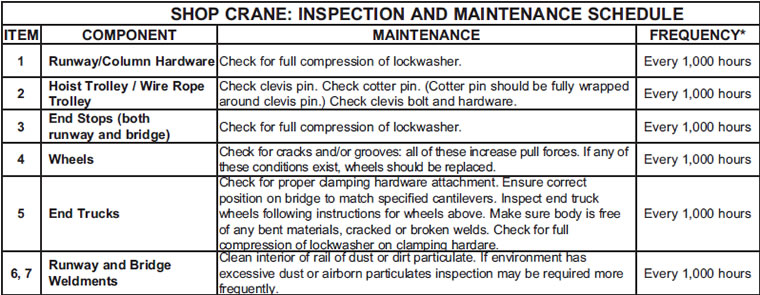 |
|
*Federal,
state and local codes may require inspection and maintenance
checks more often. Please check the
federal, state and local code manuals in your area. |
|
|
WARNING
|
Any
changes in rolling effort or unusual noises must be immediately
identified and corrected. It is not necessary to
lubricate the track or bearings. Lubricating may attract airborne
particles and may increase the rolling resistance.
(Do not use such substances as WD-40®, silicone sprays,
oil or grease on bearings or on track flanges.) |
Back to Product Page
|


